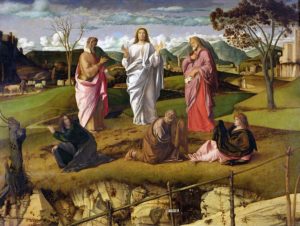Thoughts on Sunday’s Lessons for Feb. 23, 2020
First Reading: Exodus 24:12-18
Significant things happen on mountain tops, where earth and heaven come close together.

The Transfiguration of Christ (c.1480), oil painting on panel by Giovanni Bellini (d.1516), Museo e Real Bosco di Capodimonte, Naples, Italy. (Click image to enlarge.)
On Transfiguration Sunday, roughly midway between Christmas and Easter, we come to the mountain top. As we turn from the incarnate light of Epiphany toward the penitential pathway of Lent, our readings show us the awe and fear of humans encountering the divine. In the first reading we see Moses going up Mount Sinai to receive the Ten Commandments from a mighty God cloaked in clouds and fire. In the verses that came just before this reading, though, Aaron and the other leaders dined and drank with a much more accessible divine being. Humanity continues to wrestle with the contrasting ideas of an intimate God who knows our deepest thoughts, and a transcendent God who surpasses human understanding.
Psalm: Psalm 2
This Messianic hymn of praise envisions God as a mighty king, and more: King of Kings, to whom earthly kings must submit with fear and trembling. Those who seek to break away from God’s power and that of God’s anointed, the Messiah, will earn only divine derision and terrifying rage, the Psalmist sings. Such actions have consequences. But when God’s anointed is set on the holy hill of Zion, the temple, the psalm concludes, happy are all who take refuge in God.
Alternative Psalm: Psalm 99
This hymn of praise offered as an alternate reading to Psalm 2 also envisions God as a mighty king, at whose appearance the people tremble and the earth shakes. Yet, recalling that Moses and Aaron received God’s law and teaching, it also shows us a forgiving and kind God, a doer of justice, equity and righteousness. It mirrors the Exodus reading in showing a God of both distant might and present love.
Second Reading: 2 Peter 1:16-21
Modern bible scholars generally accept that this letter, perhaps the last written in the New Testament, is not the work of Simon Peter, the apostle. It was almost certainly written in Peter’s name by a leader in the early church a century or more after the Crucifixion. Still, it opens a window into the thinking of the second-century church, when believers were trying to understand why Jesus had not returned as soon as had been expected. Everything they have heard about Jesus is true, the letter reassures them, speaking as if in Peter’s own voice: Peter himself was present at the Transfiguration. Trust in God and wait for the dawn and the morning star.
Gospel: Matthew 17:1-9
Using images that recall Moses on the mountain, in words that echo God’s approving words at Jesus’s baptism in the Jordan, Matthew’s account shows us Jesus with the ancient prophets Moses and Elijah. Jesus is transfigured, glowing in dazzling light, revealed as both human and divine. It’s no wonder that Peter, James and John were terrified to hear the voice of God, but Jesus reassures them with a loving touch. Then, for the first time in this Gospel, Jesus speaks of his coming resurrection.
